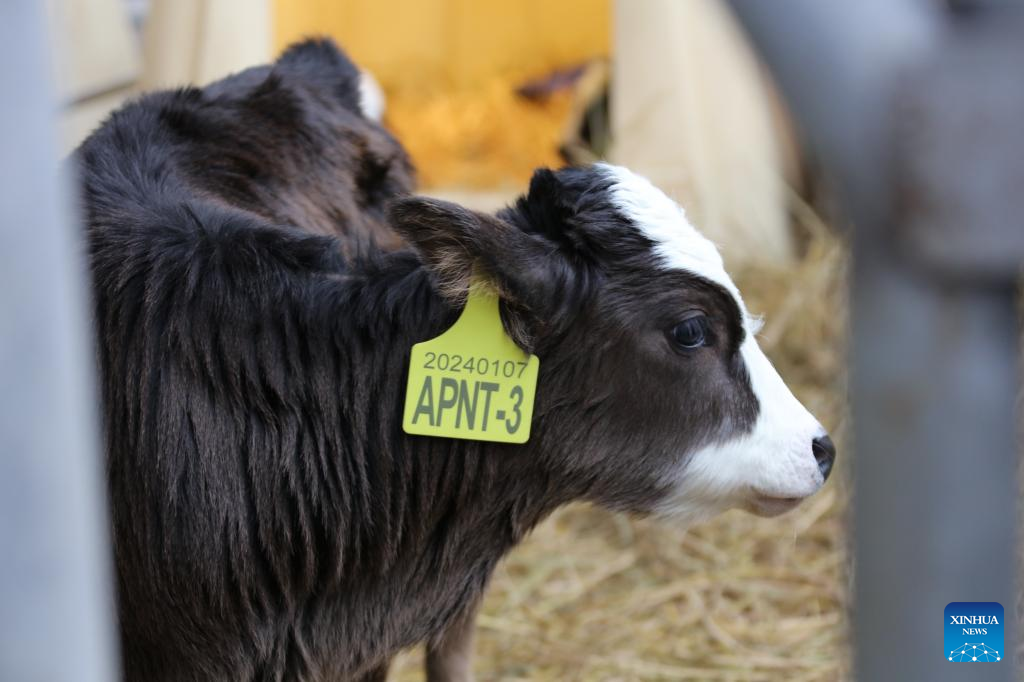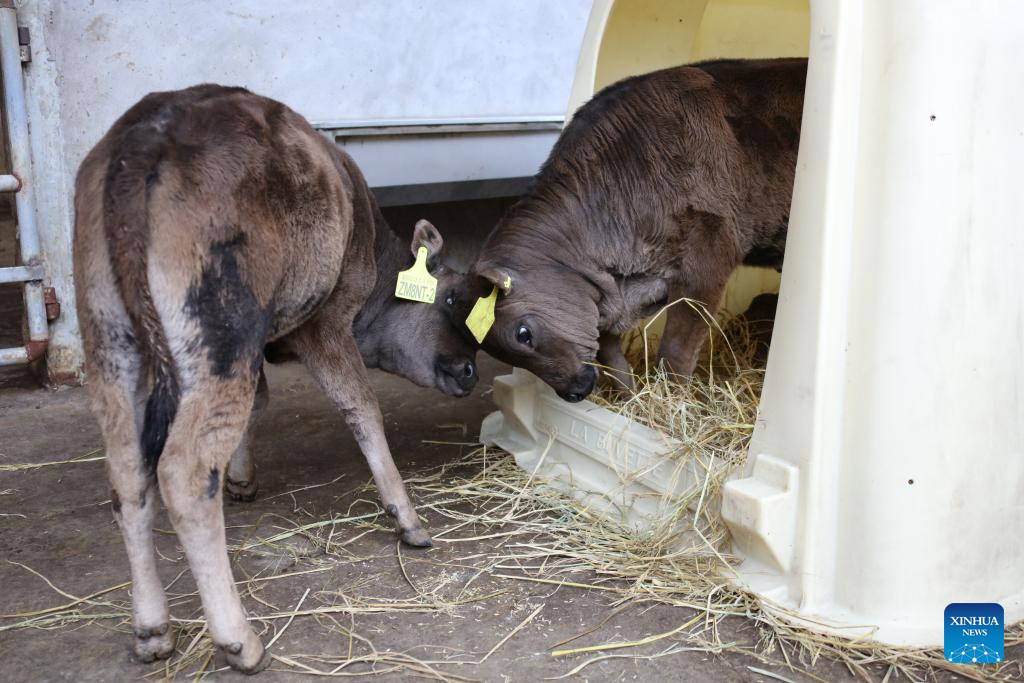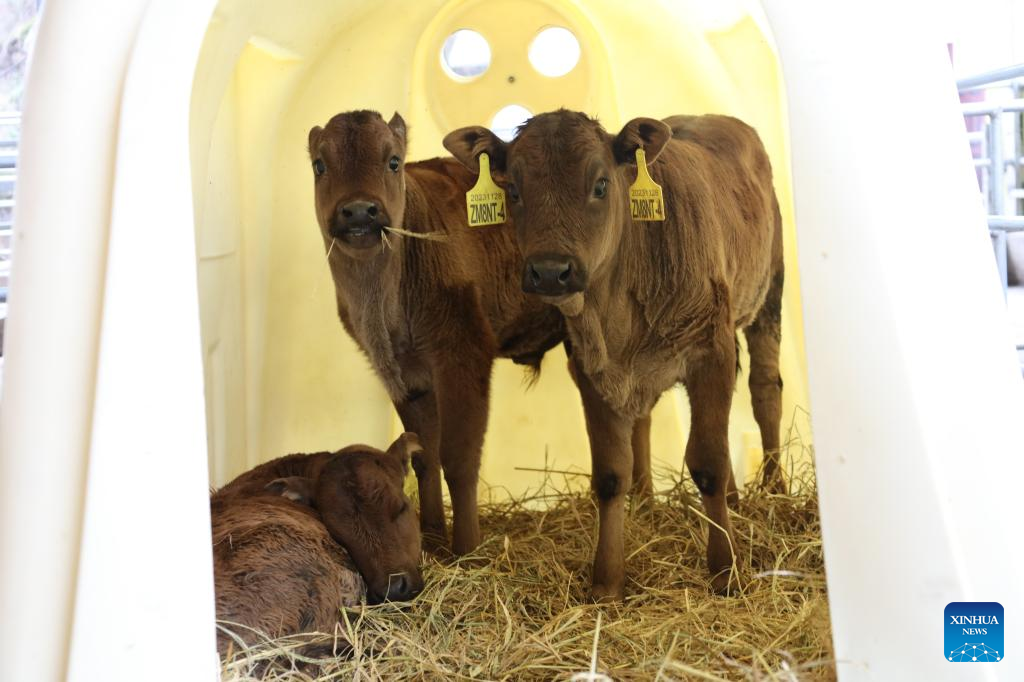


This photo taken on Jan. 29, 2024 shows clones of Apeijiaza cattle in Yunyang County, southwest China's Chongqing Municipality.
Chinese scientists recently confirmed the world's first successful cloning of endangered cattle breeds found in southwest China's Xizang Autonomous Region.
The Zhangmu and the Apeijiaza, two rare yellow cattle breeds native to the Qinghai-Xizang Plateau, are strategic resources for China, as these breeds can help researchers breed varieties well adapted to the harsh high-altitude environment.
Yunyang County in southwest China's Chongqing Municipality saw the birth of four clones of each breed and they are currently in good condition. (Xinhua/Liu Shiping)
BEIJING, Feb. 1 (Xinhua) -- Chinese scientists recently confirmed the world's first successful cloning of endangered cattle breeds found in southwest China's Xizang Autonomous Region.
The Zhangmu and the Apeijiaza, two rare yellow cattle breeds native to the Qinghai-Xizang Plateau, are strategic resources for China, as these breeds can help researchers breed varieties well adapted to the harsh high-altitude environment.
Yunyang County in southwest China's Chongqing Municipality saw the birth of four clones of each breed and they are currently in good condition.
THE METHOD
According to the third national survey of livestock and poultry genetic resources conducted in 2021 and 2022, there were just 19 heads of Zhangmu cattle in Xizang's Shigatse City and 39 heads of Apeijiaza cattle in the autonomous region's Nyingchi City.
To urgently bring these animals back from the brink of extinction, relevant departments and local authorities in China established a working group to protect the existing cattle, preserve their somatic cells, and make clones to increase their population.
Scientists collected ear tissue from the Zhangmu and the Apeijiaza, used somatic cell nuclear transfer technology to create cloned embryos and transplanted them into surrogate cows. After a full-term pregnancy, four male calves of each breed were born.
A head of the Zhangmu and three heads of the Apeijiaza were born through cesarean section, with researchers precisely determining the right timing for the operations.
WHY YUNYANG COUNTY WAS CHOSEN
As there are currently no suitable conditions for cloning in Xizang, researchers chose China's southwestern regions so that it would be convenient to deliver the clones back to Xizang.
Yunyang County was finally chosen due to its climate and terrain resembling that of the cattle's native habitat and for its cattle breeding technology.
OVERCOMING ALTITUDE CHALLENGE
Two calves of each breed will be returned to Xizang this summer, while the remaining four will be raised to adulthood in Yunyang County and their semen will be collected and frozen for preservation.
Bringing the cloned cattle back to Xizang may pose challenges related to transportation, abrupt changes in their living environment and potential risks of diseases.
These animals born in low-altitude Chongqing will be moved gradually to Xizang to help them adapt to the high altitude there.
Upon arrival in Xizang, the cloned cattle will be quarantined, carefully bred and closely monitored to ensure their health.
CLONING IN XIZANG
Scientists plan to create favorable conditions for cloning Zhangmu and Apeijiaza cows in Xizang to facilitate the rapid growth of the herd.
Experts believe that the cloning success has laid a foundation for cloning in Xizang and training specialized personnel, but technological obstacles remain to be cracked, such as obtaining oocytes and ensuring the maturity of extracorporeal embryos, among other factors.
STRENGTHENING PROTECTION IN HABITAT
In addition to striving for conditions conducive to cloning, local authorities in Xizang have also stepped up efforts for the protection of the naturally existing herd in the habitat, including setting up protection zones, creating protection cooperatives, intensifying disease control and improving animal-raising methods.
A new survey showed that nine Apeijiaza and six Zhangmu calves were born in Xizang in 2023. Researchers will work to boost the reproductive capacity of the cattle and the survival rate of the newborns.

This photo taken on Jan. 29, 2024 shows clones of Apeijiaza cattle in Yunyang County, southwest China's Chongqing Municipality.
Chinese scientists recently confirmed the world's first successful cloning of endangered cattle breeds found in southwest China's Xizang Autonomous Region.
The Zhangmu and the Apeijiaza, two rare yellow cattle breeds native to the Qinghai-Xizang Plateau, are strategic resources for China, as these breeds can help researchers breed varieties well adapted to the harsh high-altitude environment.
Yunyang County in southwest China's Chongqing Municipality saw the birth of four clones of each breed and they are currently in good condition. (Xinhua/Liu Shiping)

This photo taken on Jan. 29, 2024 shows clones of Zhangmu cattle in Yunyang County, southwest China's Chongqing Municipality.
Chinese scientists recently confirmed the world's first successful cloning of endangered cattle breeds found in southwest China's Xizang Autonomous Region.
The Zhangmu and the Apeijiaza, two rare yellow cattle breeds native to the Qinghai-Xizang Plateau, are strategic resources for China, as these breeds can help researchers breed varieties well adapted to the harsh high-altitude environment.
Yunyang County in southwest China's Chongqing Municipality saw the birth of four clones of each breed and they are currently in good condition. (Xinhua/Liu Shiping)

This photo taken on Jan. 29, 2024 shows clones of Zhangmu cattle in Yunyang County, southwest China's Chongqing Municipality.
Chinese scientists recently confirmed the world's first successful cloning of endangered cattle breeds found in southwest China's Xizang Autonomous Region.
The Zhangmu and the Apeijiaza, two rare yellow cattle breeds native to the Qinghai-Xizang Plateau, are strategic resources for China, as these breeds can help researchers breed varieties well adapted to the harsh high-altitude environment.
Yunyang County in southwest China's Chongqing Municipality saw the birth of four clones of each breed and they are currently in good condition. (Xinhua/Liu Shiping)
点击右上角![]() 微信好友
微信好友
 朋友圈
朋友圈

请使用浏览器分享功能进行分享
